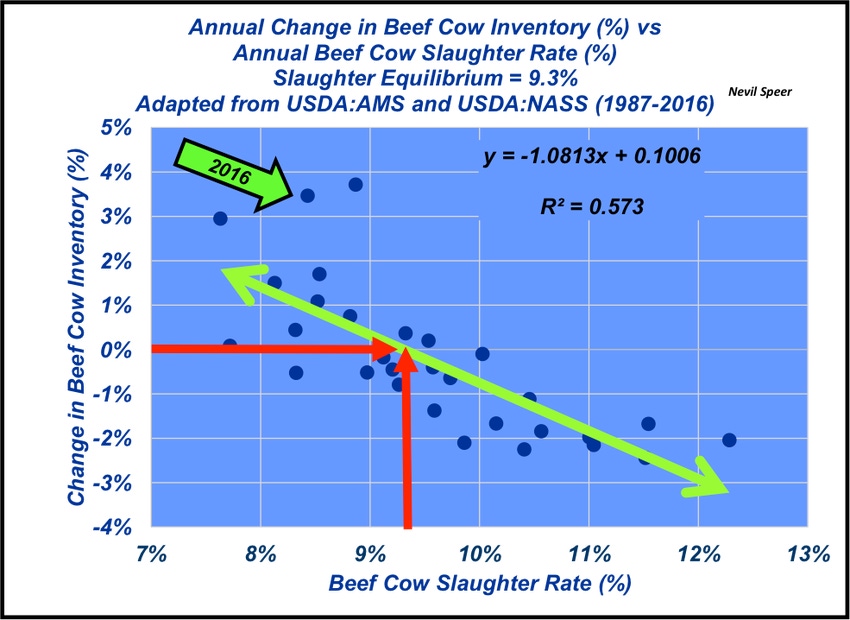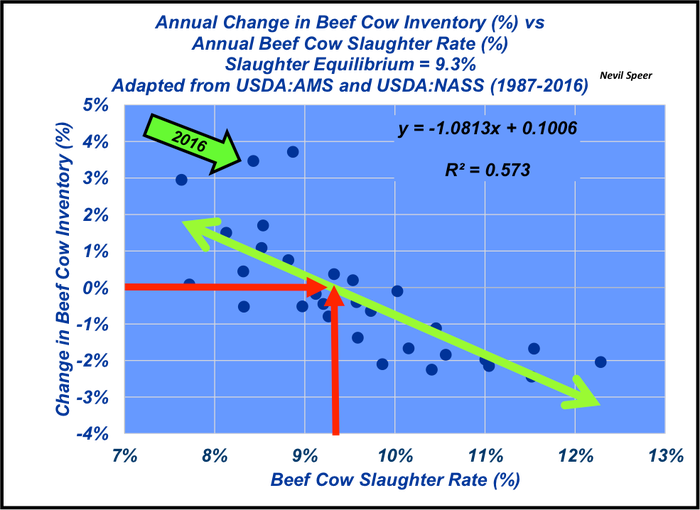Cow slaughter trends indicate future herd size
How now, brown cow? And black and white and all the colors in between. Will there be more of you in 2017?
February 16, 2017

The New Year started with even more cows than expected. USDA’s Cattle inventory report indicated producers currently hold 31.2 million cows – versus 30.17 million cows in 2016. Moreover, 2017’s inventory is 2.2 million cows bigger than the low-water mark of 29.1 million head in 2014. Clearly, higher prices have encouraged the cow-calf sector to retain heifers and keep back more cows along the way.
To that end, beef cow slaughter is a fairly reliable indicator of how big next year’s cowherd will be. This week’s illustration highlights annual change in beef cow numbers (%) vs. the previous year’s beef cow slaughter rate (%). Within that analysis, a couple of things are important.
First, and foremost, the equilibrium slaughter rate, as a percentage of January 1 inventory, runs around 9.3%. That is, slaughter rate above 9.3% likely means liquidation, while slower slaughter leads to expansion.
For example, the 2016 slaughter rate equaled 8.4% of starting inventory, indicating producers desired to retain more cows in 2017. Interestingly enough, expansion last year equaled 3.4% - one of the clear outliers within the data as indicated on the graph – the others being 1993 and 2015.
Second, and not surprisingly, there’s essentially a one-to-one relationship between slaughter rate and the subsequent change in cow inventory. In other words, if slaughter exceeds the equilibrium by 1%, the expectation is that cow numbers will be 1% smaller in the following year.

All of that is fairly straightforward. However, it provides an important base to work from in terms of expectations, from both a broad perspective and from a month-to-month monitoring perspective (more on that next week).
How does this analysis compare to your individual experience? For you to maintain cow numbers, would you expect about a 9% to 10% cull rate? If you’ve grown your herd in recent years, what’s been your culling rate to do so? What are your expectations for the coming year in terms of expansion plans? Leave your thoughts in the comment section below.
Nevil Speer is based in Bowling Green, Ky., and serves as vice president of U.S. operations for AgriClear, Inc. – a wholly-owned subsidiary of TMX Group Limited. The views and opinions of the author expressed herein do not necessarily state or reflect those of the TMX Group Limited and Natural Gas Exchange Inc.
About the Author(s)
You May Also Like





